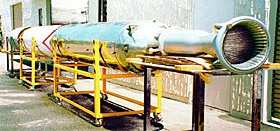Revitalized X-Prize Contender Sets New Goal
Last week AERA, a new company, created a stir among space
watchers when it promised that it would launch space tourists by
2006. Why, how can a new, unproven company get started that quickly
while Mojave Aerospace Ventures, the victorious X-Prize team of
Allen and Rutan, is still reported to be in early stages of
building SpaceShipTwo -- the enlarged, redesigned space tourism
ship that we previously reported?

Well, as it turns out, AERA isn't all that new. It was an
X-Prize contender itself, as American Astronautics Corporation
(AAC). (Indeed, if you follow a link to www.americanastronautics.com,
it takes you to the new company's website). American Astronautics'
X-Prize contender, The Spirit of Liberty, was designed from the
outset as a space tourism vehicle -- indeed, AAC's X-Prize info
sheet says that the Spirit is the "first production unit of the AAC
Starliner Model 7S rocket ship, specifically designed for
commercial operations serving the emerging commercial space tourism
industry." AERA's spaceship, the Altairis, will not be unveiled
until a media event in March, but the smart money says it will
strongly resemble The Spirit and its Starliner booster.
The two top executives of AERA provide some clues to how it
developed from AAC. The Chairman & CEO, and Chief Scientist, is
Bill Sprague, a space-launch industry veteran who has worked for a
who's who of the commercial and military space industry and worked
on, or headed up, a what's what of American launch projects, manned
and unmanned. Sprague was also the head of AAC. Joining him in the
executive suite is Lewis Reynolds as President and COO, who despite
his youthful appearance, has had an equally successful career in
banking and investment finance. "Mr. Reynolds joined AERA
Corporation after arranging a significant venture capital
investment for the company," his corporate bio tells us.
So that's their formula -- start with genius. Apply money. Well,
it worked for NASA and it worked for Rutan! It could work for AERA
as well.
Sprague stresses the safety of his approach. "We employed 30
years of proven technology and improved upon it with modern
capabilities to develop Altairis, our first generation spacecraft.
AERA's commitment to the space travel experience is surpassed only
by its commitment to safety," he promised. On the website, AERA
claims that Altairis is "the safest space flight system ever
created."
Reynolds agrees that the company is moving ahead of competitors.
"We are not only positioned to become the first space travel
provider, but are two years ahead of the competition."
With AERA, much of the American symbolism and verbiage
surrounding AAC is toned down (suggesting, perhaps, foreign
investment), but the system remains a vertical launch, parachute
recovery system based primarily on proven 1960s NASA concepts. The
engine is a conventional LOX/Kerosene type.

No specs have yet been released for Altairis, but the look for a
22,000 pounds gross weight at takeoff, 35,000 pounds of thrust and
a peak acceleration of 4G. The vehicle stands 56 feet tall on its
vertical launch pad, and is a max of about five feet in diameter.
The widest part is the passenger cabin which holds seven
passengers.
Unlike SpaceShipOne, the commander of the flight has little
control during ascent and re-entry -- in this way, also, it is much
like a Mercury flight. Where the AERA/AAC project differs from
1960s practice is in its landing, thanks to over 40 years of rapid
innovation in parachute technology. The booster and the crew cabin
will recover separately to the launch site using GPS-controlled
ram-air parachute systems or "parafoils." An inertial navigation
system backs up the GPS. The two elements of the craft glide in to
touch down on airbag cushions.
AAC is not the only X-Prize contender to make the commercial
move. As we note in another article, several other X-Prize
contenders are now aiming at other, potentially lucrative,
targets.
 ANN's Daily Aero-Linx (04.15.24)
ANN's Daily Aero-Linx (04.15.24) Classic Aero-TV: 'No Other Options' -- The Israeli Air Force's Danny Shapira
Classic Aero-TV: 'No Other Options' -- The Israeli Air Force's Danny Shapira Aero-News: Quote of the Day (04.15.24)
Aero-News: Quote of the Day (04.15.24) Airborne 04.16.24: RV Update, Affordable Flying Expo, Diamond Lil
Airborne 04.16.24: RV Update, Affordable Flying Expo, Diamond Lil ANN's Daily Aero-Term (04.16.24): Chart Supplement US
ANN's Daily Aero-Term (04.16.24): Chart Supplement US




